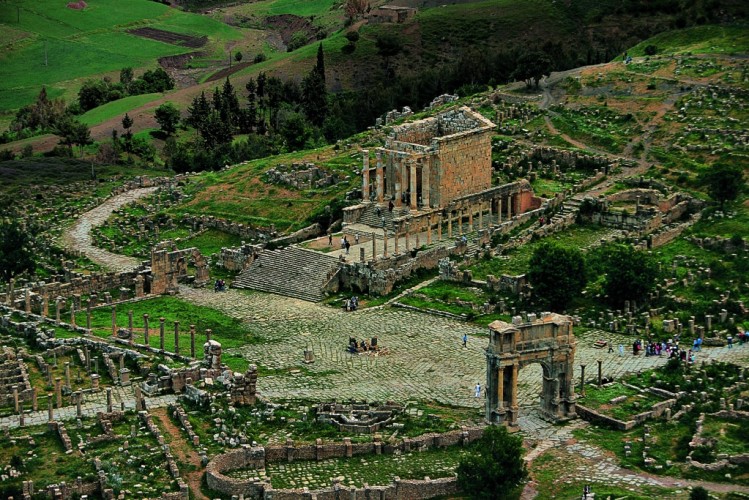Sharjah Archaeology Authority (SAA), recently organized a virtual lecture entitled, "Archaeological heritage in the provinces of Numidia and Mauritania from the 3rdcentury BC to the 3rdcentury AD.” The lecture was moderated by Dr. Hind Ahmed Abu Shaheen, head of tourism, Egyptian Youth Council, who spoke about six sites and museums; including the Cirta National Museum, Jamila Site and Museum, Musée de Timgad, Archaeological Public Museum of Cherchell, Sétif Archaeological Museum and Roman Mosaics.
The presentation was part of a series of weekly lectures organized by the authority, with the aim of raising awareness about restoration and maintenance of antiquities. Over 150 archaeology enthusiasts from within the region and outside attended the lecture.
Dr. Shaheen said: “These six sites are related to a certain extent with my master’s and doctoral studies, and my specialization in archaeology. These historical sites contain monuments that indicate their significance throughout history, civilizations and social groups that lived there. "
Cirta National Museum, Constantine
The Cirta National Museum is one of the oldest museum in Algeria today. It opened its doors to the public in 1931 and was named after the historical city of Constantine. The museum includes a large number of artifacts that had been discovered, reflecting the history of the region, the civilizations that succeeded it and the various social groups settled there.
The museum extends over an area of 2,100 sq.m., of which about 900 sq.m., is an archaeological park. The archaeological groups in the museum are divided into two main parts including, the Department of Antiquities, consisting of thousands of pieces; a large part of which is displayed across 12 hallsin a chronological order. The rest are preserved in the museum’s warehouses and the Fine Arts Department; which displays watercolors, sculptures, and other works of art. Among the most important archaeological treasures in the Great Hall are the mosaics dating from the mid-2nd century BC to the 4th century AD. A numismatics hall in the museum, represents different historical periods, such as the Numidian and Roman.
Jamila Site and Museum
Jamila or Kouykol, an archaeological and historical Roman city located in the northeast of Algeria, in rugged and barren regions, was covered in the past by forests and wheat spikes. Throughout history it is one of the most important cities of Numidia, with a museum full of archaeological pieces and findsand many Roman archaeological monuments Important and unique. It also contains the tomb of Bacchus, which is inspired by the myth of Dionysus, and it consists of a garden with a courtyard and three rooms that are roofed with gravestones and columns, while the backyard has mosaics and sculptures.
Musée de Timgad
Musée de Timgad, located in the northeast of Batna, derives its importance from the rare mosaics that made it an invaluable gem/ The museum is made of 86 mosaic panels of various sizes, most of which are displayed to visitors, across three halls.These speak about the daily life and beliefs of the Romans.
Timgad is a city built in a square shape, emulating a chessboard, surrounded on both sides by two main roads; between which dozens of secondary paths are spread across edges of houses, food preservation centers and water stores are located, along with the temple, the cathedral and the circular theater. In the middle of Timgad is a large square that forms the link between all its parts. UNESCO listed the site among the World Heritage Cities in 1982.
Sétif Archaeological Museum and Roman Mosaics
Seen as an open window on the history of Algeria, it is one of the important archaeological sites located in the Algerian city of Sétif. It includes many artifacts and monuments, reflecting the civilization and history of Sétif. The museum includes a number of attractive Roman mosaics, including the famous mosaic, ‘Triumph of Dionysus‘, which is considered to be one of the most popular pieces in the Roman world.
The museum includes six halls, namely, the prehistoric hall, the Roman art hall, the Islamic art hall, the numismatic hall, the mosaic hall, the exhibition hall, in addition to the facades of traditional tools, the restoration laboratory, the archaeological tools store, the library, the administration, and a hall. The Prehistoric Hall contains a rare collection of artifacts that reflect the stages of human settlement.
Historic site Tipasa
The Museum opened its doors in 1955 and boasts of a reception space, an outdoor garden surrounded by a courtyard and a large exhibition hall containing various artifacts of funeral furniture for the Roman periods, in addition to various mosaics and statues.
Tipaza (the corridor or transit area), which is located on the Algerian coast, had a significant commercial position, especially during the reign of the emperors of the 2nd and 3rd centuries AD. In the 3rd century AD it was one of the headquarters for bishops, surrounded by a great wall and 37 guard posts.



